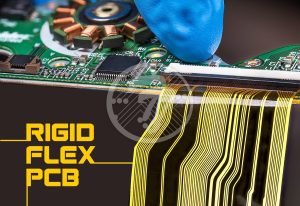Manufacturing Rigid Flex PCBs
Rigid flex, or rigid-flex PCBs, are circuit boards that contain both a rigid section and a flexible section. These are used in a variety of applications, including the cameras in mobile phones, screen signal connection in laptops and tablets, and other electronics that require bending. The fabrication process for a rigid flex board involves combining one or more 2-layer flex sections embedded between multiple layers of rigid material. In this example, the layer stack up would look like this:
To create the rigid flex board, the flex sections are first laminated to a rigid base using an adhesive (or in some cases, no glue at all). Then copper foil is bonded to the top and bottom of the flex. This is done either through an adhesive or via a chemically treated copper layer known as “adhesiveless” cladding.

Both cladding options provide the same electrical performance, but the adhesiveless technique saves time and money. The flex circuits are then plated through and etched in the same steps as a normal 2-sided rigid board. This is followed by routing the traces, solder mask, and any holes in the flex circuit.
Fabrication Techniques Used in Manufacturing Rigid Flex PCBs
During the fabrication process, it is important to consider mechanical stress that could be applied to the flex circuits. For this reason, it is recommended to route the flex circuits perpendicular to the bend line, and add dummy traces along the bending area to help support the structure. This can prevent premature failure of the flex-rigid interface, and ensure signal integrity, and EMI control.
Another challenge is coordinating the thermal expansion of the rigid and flex sections. Different materials have varying coefficients of expansion, which can cause reliability issues over temperature ranges. A good manufacturing team will carefully balance these factors.
In addition to ensuring the proper fabrication techniques, a rigid-flex manufacturer should also perform comprehensive testing of the completed product. This should include environmental testing, such as humidity and temperature exposure, drop/bend/twist testing, flexural fatigue testing, and detailed root-cause analysis of any electrical problems.
The best way to improve a rigid-flex PCB design for manufacturing is by working closely with the fabricator early in the design process. This will help to optimize the design for manufacturability and cost, and ensure that existing fabrication standards are met. It is also a good idea to build prototypes to verify that the design meets the required performance, quality, and manufacturability targets before production.
 This can save a lot of expensive mistakes later in the process. This is particularly true for multi-layer rigid flex designs that can be difficult to test in full production. To minimize risk, designers should work with a rigid-flex PCB manufacturer that has the experience to deliver quality results at competitive prices. This will help to avoid the expensive rework and revision cycles that plague many other PCB manufacturers.
This can save a lot of expensive mistakes later in the process. This is particularly true for multi-layer rigid flex designs that can be difficult to test in full production. To minimize risk, designers should work with a rigid-flex PCB manufacturer that has the experience to deliver quality results at competitive prices. This will help to avoid the expensive rework and revision cycles that plague many other PCB manufacturers.





